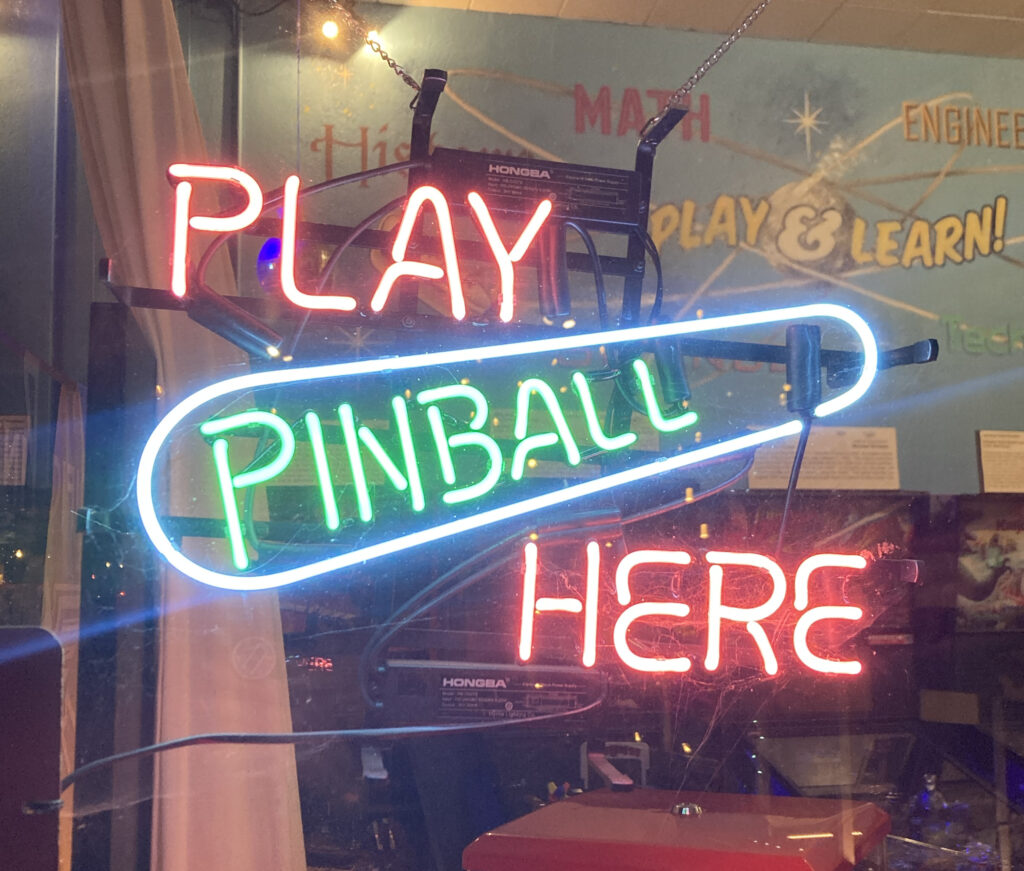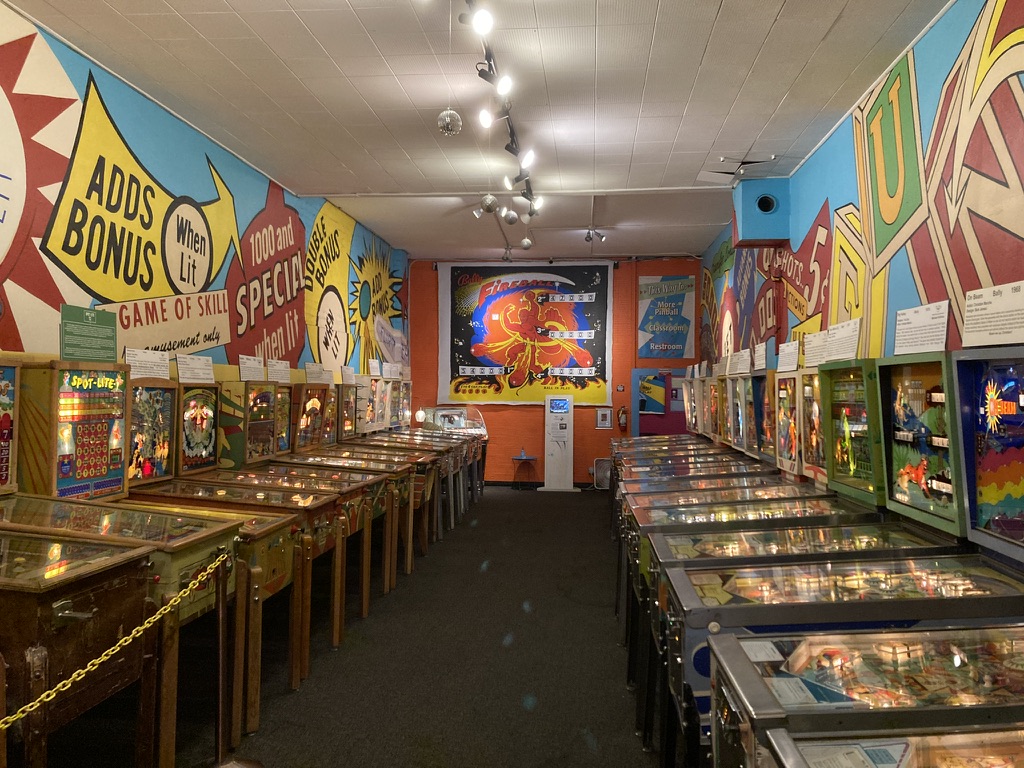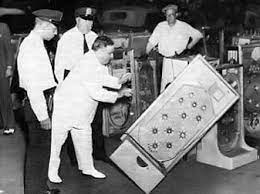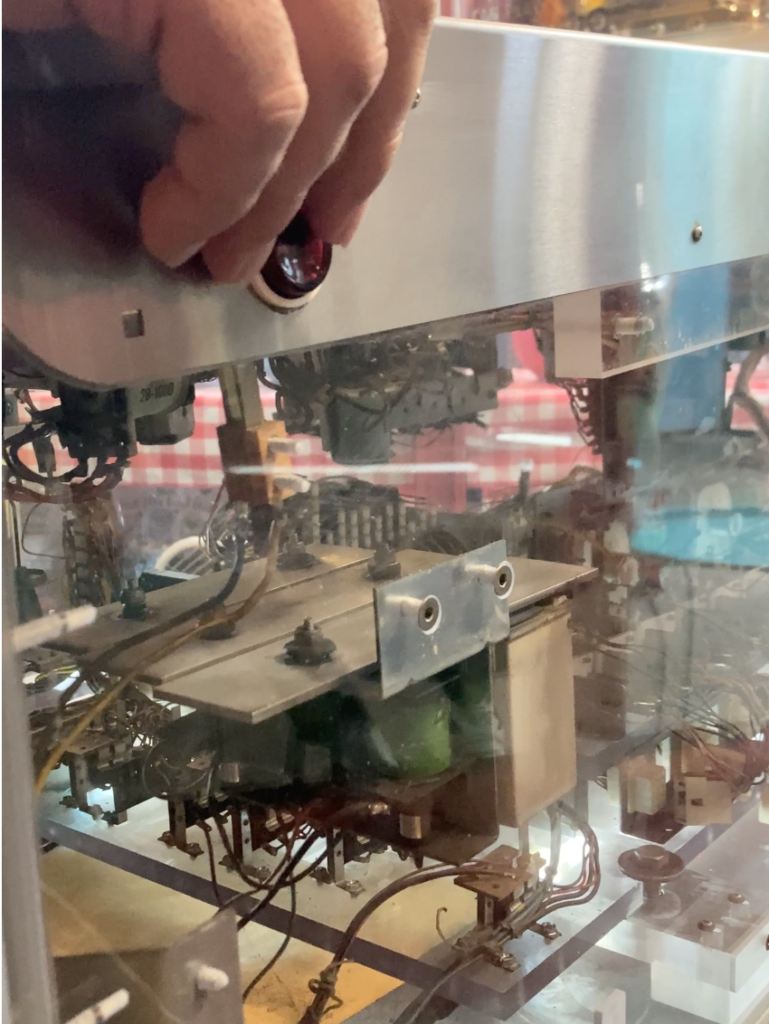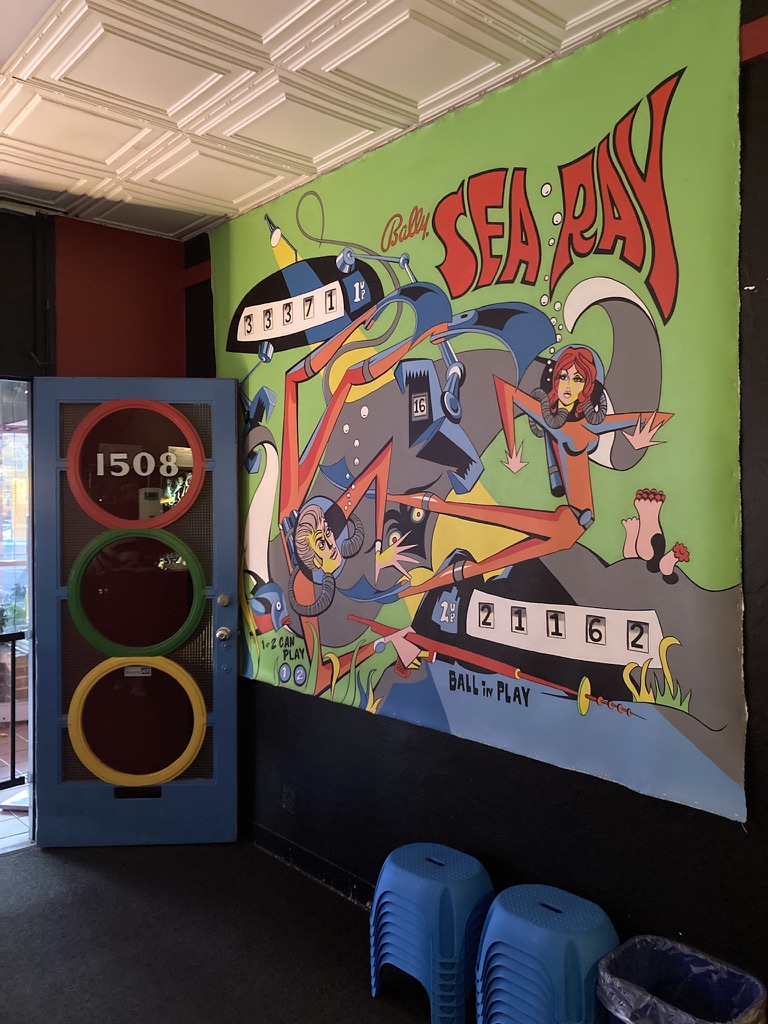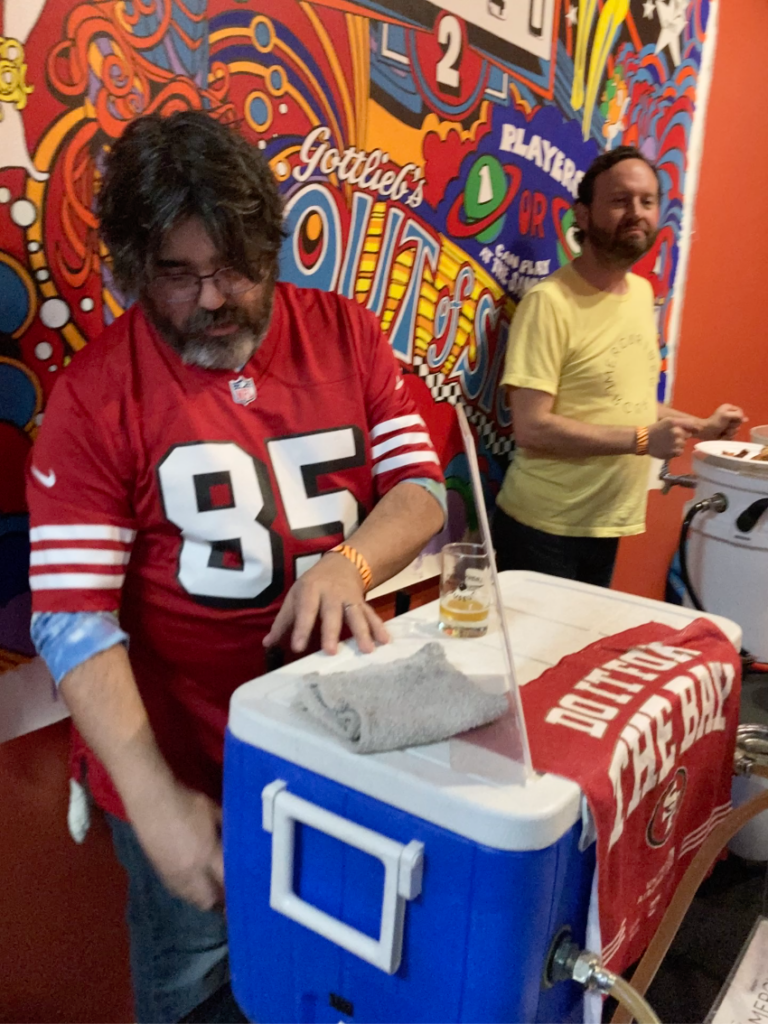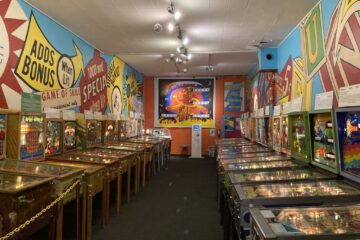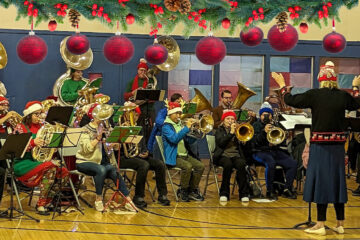The Art and History of (Illegal) Pinball in the Bay Area
The Pacific Pinball Museum (PPM) in Alameda hosts multiple rooms with a rotating cast of over 100 pinball machines from the 1940s – present, all in playable order. I attended Pinball and Pints at the PPM as part of SF Beer Week. Friendly folks sharing their passions of pinball and local brewing, I gotta tell ya, it was the best.
As for the PPM staff and guests at the event, everyone seemed pumped to be there and share their knowledge and enthusiasm for the game. There were side quests such as one-handed pinball competitions, with prizes of free PPM passes and swag. Best of all, I learned a TON about pinball, and as a history nerd with a penchant for trivia, I walked out of there with an armful of fun facts. I love fun facts.
Fun fact: Before 2014, pinball was illegal in the Bay Area, and we can thank the Pacific Pinball Museum in Alameda for changing that.
Pacific Pinball Museum and Why The Wild History of Pinball
The PIN in Pin-ball:
Early versions of pinball (and Bagatelle, pinball’s predecessor) consisted of a simple wooden board set on an angle and a spring shooter that flung a marble through clusters of nails (pins) and targets that were designated point areas. The spring shooter, patented in 1871, is still being used today.
Ballyhoo, designed by Lion Mfg Co., emerged in 1932. Although it was the same design of earlier versions of pinball, the board was wonderfully garish and exciting to look at. This game was so popular, the company that created it changed their name to Bally, (yes, that Bally, of Bally’s resort, casino, gyms, and arcades fame – fun fact!). From here, pinball art and themes became just as important as the game itself.
Apparently there was a slippery slope between this parlor game and ties with the Mafia that changed the trajectory of the next near-century of pinball. The pre-mechanized saloon-game incarnation of pinball were bystanders associated with gambling and organized crime and was therefore outlawed in most major cities in the US in the 1930s and 40s.
NYC Mayor LaGuardia, in his crusade to “clean up crime,” had thousands of pinball games destroyed, dumped into nearby bodies of water, and boasted that the wooden legs of the pinball games would be refashioned into police billy clubs.
Flipper, the game changer
As the decades of delinquency dabbled on, pinball manufacturers continued to make technological advances. In 1936, the Bally Bumper was the first machine to go electric (Fun Fact: The Bally Bumper was one of many that were confiscated by Oakland Police. Some were given to police in Alameda as gifts. The PPM has two of these.)
The 1940s, 50s, and through the 70s, electromechanical machines lit up the game. Lights, sounds, and mechanical scoring added a level of excitement, but it was the electromechanical flipper, added to pinball machines in 1947, that was a literal game changer. What was once a game of chance could be loosely considered a game of skill by controlling the flipper and flinging the silver ball into somewhat intended directions (except for flipper and button mashers like myself).

Humpty Dumpty, 1947, the first pinball game with flippers (that admittedly look a bit higgeldy-piggeldy). This game is playable at the PPM.
When it was deemed that pinball was a game of skill, the law was overturned in Los Angeles in 1974. Two years later, GQ reporter Roger Sharpe famously called his shots and played pinball for the courts in New York City which ended the pinball ban there. Still, the laws remained on the books in the Bay Area for another 40 years.
Enter Michael Schiess.
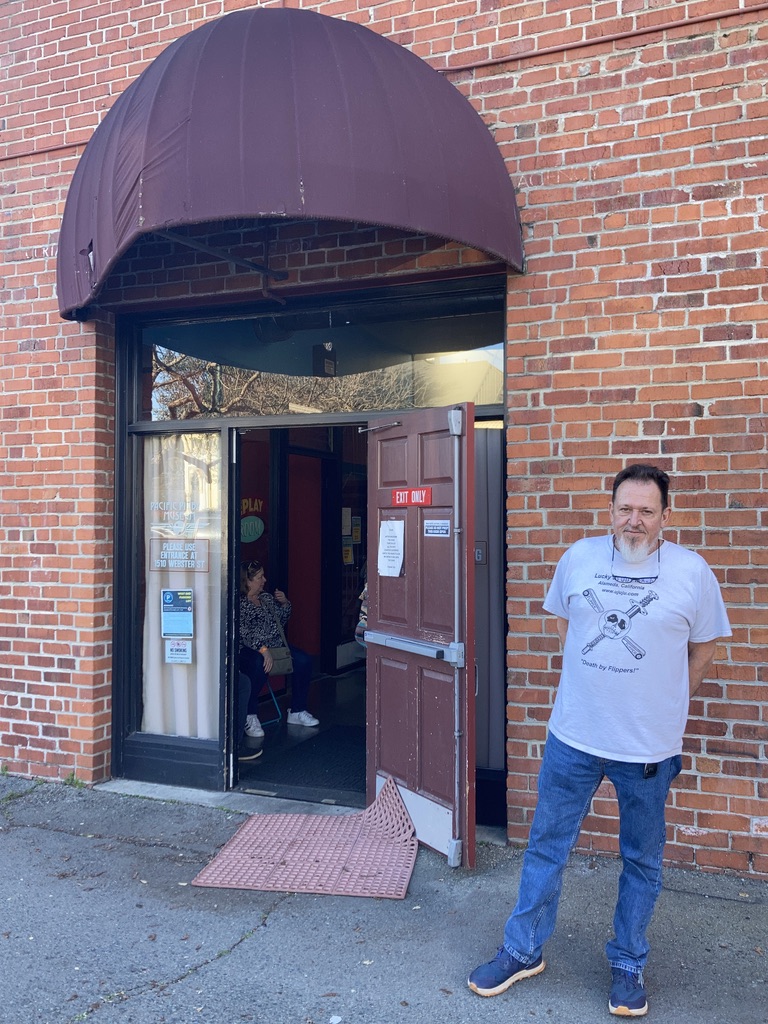
Michael Schiess, founder of Pacific Pinball Museum, standing in front of the original entrance in a back parking lot.
Schiess founded the Pacific Pinball Museum in Alameda 21 years ago under the name Lucky Juju. At that time, it was a single room with under a dozen games. Yes, pinball was not yet legal, hence the museum designation, but what started as a small donation-driven speakeasy clubhouse expanded into five rooms as a 501(c)3 non-profit and created a community. According to Schiess, the PPM was never meant to solely be an arcade, “it was supposed to be a place where you learn about art and about technology and about history.”
Schiess previously had worked in the Exhibit Development Workshop at the Exploratorium. He continues to be inspired by interactivity and the open workshop model, where visitors can see the works in progress. In his own shop, Wade Krause, Christian Schiess, and Michael Schiess replaced pinball frames with clear acrylic so the internal guts and mechanisms could be visible. Inside you can see that the sounds that were made, say, when bumpers were hit, was an ACTUAL XYLOPHONE INSIDE THE MACHINE!
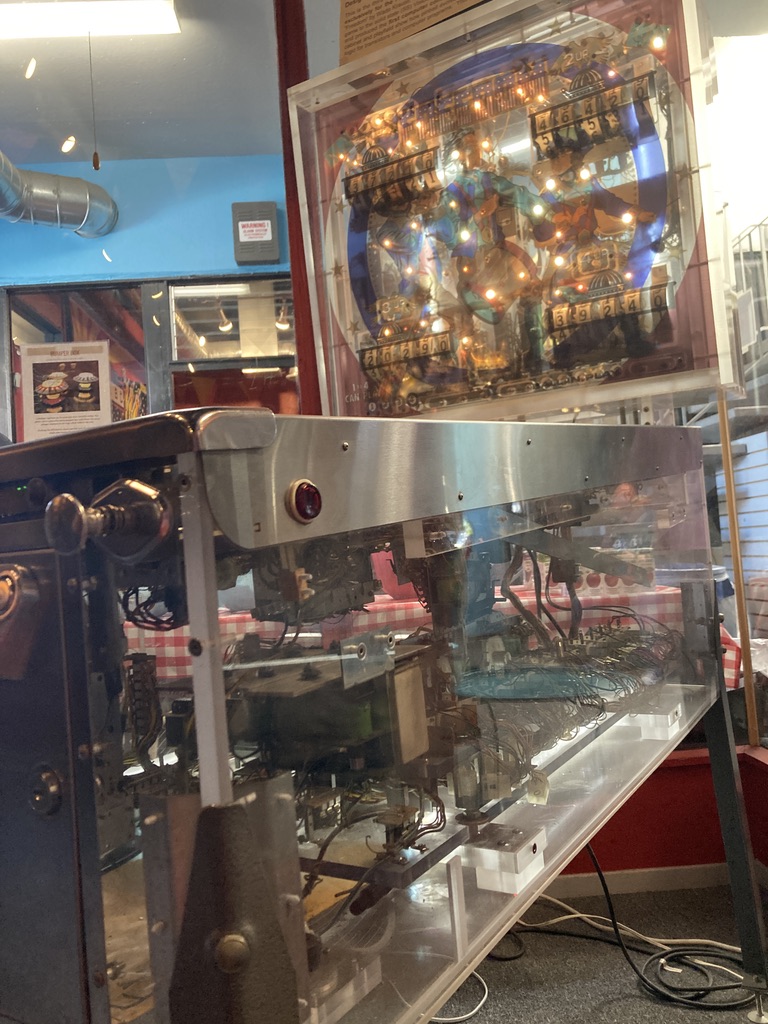
Here, the pinball machine frame was replaced with clear acrylic so players can see working mechanisms inside the machine.
The PPM prides itself on being inclusive, safe, and community oriented. “Play and Learn” school field trips and summer camps for kids to learn about physics, engineering, and science. There are also treasure hunts, word searches, and self-guided tours for all ages to enjoy.
League Nights on Wednesdays (Adults) and Children (Saturday mornings) welcome all skill levels.
Art: All of the hand-painted large murals of the Pinball Machine “head art” are all for sale. The proceeds are shared between the artist and museum.
Pinball exhibits: Pointy People celebrates angular humanoid art from the 60s-70s. This long-running exhibit will be up for another few months, and they will be welcoming a new one this summer. The next exhibit will rotate in games that feature sci-fi/fantasy pinball artist Gordon Morrison.
The over 100 machines at the PPM are arranged, room by room, in chronological order. Each room has a jukebox loaded with music associated with the era, and they have a steady inflow of new and modern games. The entry to the Museum is free to look around, or pay admission and play unlimited games all day. Or better yet – become a member!
There are more than 1300 pinball machines in storage, and the PPM is currently fundraising for a bigger space to have more available to the public (in addition to their current location), which would include a working workshop where visitors can see pinball machine repair/restoration in progress, like at the Exploratorium. Here is a 360 peak into their storage facility when it was set up for an Expo event.
How did pinball become legal in the Bay Area?
Not to make a favorable result sound anticlimactic, but in 2014, Schiess and a few PPM board members reached out to the Alameda and Oakland City Councils, basically to make it clear that the law was dumb. “Pinball never hurt anyone, unless you tried moving (a machine),” says Schiess. And like that, simply, the law changed – it must be that “lucky juju” that made it easy.
Oakland ends ban on pinball after nearly 80 years
The PPM is in talks about exhibiting at the Alameda County Fair this summer, and the Fairgrounds staff suggested placing them near the horse racing track. Some reputations are just hard to shake.
Featured Brewers at Pinball and Pints
There was nothing I didn’t love about the beers feared at Pinball and Pints, and I was impressed with the variety of flavors. All the brewers were so supportive of each other in that soothing GBBO kind of way.
Mercurius (Potrero, San Francisco) Featured unique and delicious beers such as the Ma La Hot Pot DIPA with galangal, lemongrass, and Szechuan pepper (!!!), and Roasted Banana and Bread Pudding Weizenbock (smelled like banana, tasted like caramel!). They also teach homebrew classes.
Copper (Castro, San Francisco) LGBT owned, brewed right inside Copper restaurant. In fact, they worked the microbrewery into their restaurant after taking classes at Mercurius. What a world! I sampled their Hazy and Saison.
Alameda Island Brewing – Traditional, eclectic, and Filipino flavors. Their Ube Area Ale (hell yeah!) and Nelson As Pale Ale were fantastic and fresh.
Faction Brewing Alameda classic, specializes in hoppy beers without the bitterness. Playing cornhole and catching the view of SF from their brewery is a beautiful way to spend a sunny weekend.
dahoam 1516 – a 501(c)(3) school and social club in Alameda, classes in German cooking and brewing. They grow their own Bavarian hops and produce on site.
Like Beer? Drink in the BAS Beer Passport! East Bay , SF
WANT TO SUPPORT PACIFIC PINBALL MUSEUM? YOU CAN FIND THEM ONLINE HERE:
Instagram: @pacificpinball
Facebook: facebook.com/pacificpinball
Website: pacificpinball.org
View this post on Instagram

Howdy! My name is Katy Atchison and I'm an Associate Editor for Broke-Ass Stuart.
I want to take the time to say thank you for supporting independent news media by reading BrokeAssstuart.com. Supporting independent news sources like Broke-Ass Stuart is vital to supporting our community because it amplifies the voices of a wide variety of diverse opinions. You also help support small businesses and local artists by sharing stories from Broke-Ass Stuart.
Because you're one of our supporters, I wanted to send over a pro-tip.
Our bi-weekly newsletter is a great way to get round ups of Broke-Ass Stuart stories, learn about new businesses in The Bay Area, find out about fun local events and be first in line for giveaways.
If you’d like to get our newsletter, signup right here, it takes 5 seconds.


